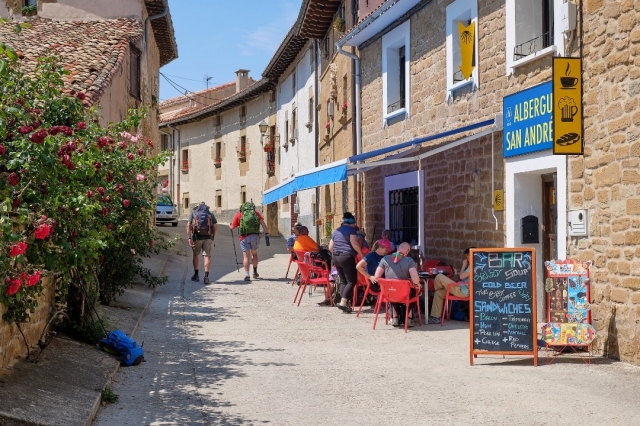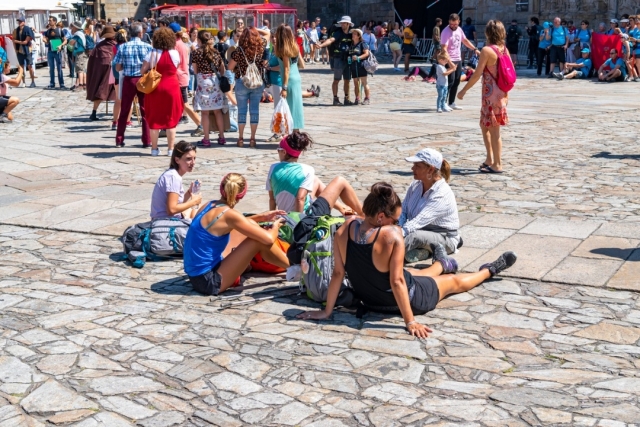De-escalated on the Camino de Santiago by the coronavirus (COVID-19)
We clear your doubts as much as possible and inform you of the situation of the Camino de Santiago at the moment before the Covid-19 (and how the scheduled de-escalation will affect it)
- De-escalation phases
- When can we return to the Camino de Santiago?
- What preventive measures should we pilgrims take?
- How will the Caminos shelters adapt after the coronavirus?
- Will it be safe to do the Camino de Santiago after the coronavirus?
- Which route of the Camino is most recommended to avoid crowds?
- If I come from outside Spain, can I do the Camino de Santiago?
How is the cursed coronavirus crisis going to affect our pilgrimage? How will de-escalation condition us? We all know that 2020 is not going to be the year the Camino de Santiago was waiting for, at the gates of Xacobeo 2021, however there is still a long year ahead to recover. The most important thing at the moment is to keep us informed in order to plan our trips and adapt to the recommendations, on and off the Camino.
For this reason, we want to clear your doubts as much as possible, and inform you of the situation of the Camino de Santiago at the moment before the Covid-19 (and how the scheduled de-escalation will affect it). According to the data provided by the Government of Spain, July will be the month in which normality recovers, and therefore, when it is allowed to return to the Camino de Santiago as we knew it.
However, this fact will not occur instantaneously: the de-escalation that is currently taking place will be correlative to the Camino de Santiago. They have programmed up to 4 phases throughout May and June: we will analyze each phase below and the respective measures that will be implemented in each of them.
De-escalation phases
- PHASE O. Spain remains immersed in a state of alarm and confinement is maintained. Started on May 2, it is expected to end on May 10, although it could last until June. During this stage, relief measures will be established that will allow people to gradually return to normal, however, the Camino de Santiago will continue to be closed.
- PHASE 1. It is planned, if sanitary conditions allow, that the first phase will begin on May 11 in each Spanish province. The reopening of:
- Hotels and tourist accommodation, excluding common areas.
- Places of worship and museums (including the Cathedral of Santiago), with a third capacity and with agglomeration control.
- Small shops, open-air markets and bar terraces at 30% of capacity.
- Active and nature tourism for limited groups.
The Camino de Santiago will be influenced in this phase by the measures taken such as: the opening of the Cathedral of Santiago (with a third of the forum and with control of the agglomerations). They will open the terraces to 50% of their capacity, small shops and open-air markets. And finally, you can practice active and nature tourism for limited groups of people, only within the same province.
- PHASE 2. After 15 days, a new phase will begin. These are the measures that will take effect:
- Opening of common areas in hotels and tourist accommodation (with a third of the capacity).
- Places of worship will increase their capacity to 50%.
- It can be consumed inside bars, cafes and restaurants, with a capacity of one third, only at the table and with the appropriate safety distance between customers.
- Opening of shopping centers, but without access to common areas.
Santiago's road. In phase 2, active and nature tourism will continue to be allowed, this time for larger groups of people. You can also visit monuments and other cultural facilities, always maintaining a limited capacity.
- PHASE 3. On June 8, if everything goes well, the last phase will begin for the return to normality.
- Opening of all activities, although the capacity of 50% will be maintained in shops, restaurants, cafes and bars.
All activities will be carried out within the same province, since in principle, it is not foreseen that trips can be made between different communities until the end of phase 3.
Phase requirements:
- Duration. Each stage will have a minimum duration of 15 days. It will only be passed from one to the other, if the sanitary criteria considered by the Government are met.
- Provinces. The de-escalation will not be done in a systematic way, since each one will have a specific situation. The rules will be common, but the measures will be carried out by provinces.
- Travels. In the 1,2 and 3 phase it will be allowed to travel but only within the same province. Free movement between provinces will only be possible when all the phases are over. As for international travel, data is not yet available, as the borders remain closed, at least until May 10. From there, the Government will incorporate new measures.
When can we return to the Camino de Santiago?
There is still no stipulated and safe date to return to the Camino de Santiago, since everything will depend on the evolution of the Covid-19 pandemic. It will be necessary to closely follow the indications that the Government of Spain is announcing regarding this issue. So far, we are certain that even in May and early June, we will not be able to return to the Camino. Although the reopening of hotels and tourist accommodation occurs, it will NOT be possible to circulate between provinces until Phase 3 is completed in each of them.
What preventive measures should we pilgrims take?
The preventive measures that pilgrims must take when everything returns to normal, in addition to the common sense and hygiene that we have taken so far, have not yet been announced. However, until now the prevention measures recommended by the Ministry of Health and the World Health Organization (and which are also applicable to the context of the Camino de Santiago) are:
1. Use of gloves and masks.
2. Wash your hands frequently, with soap and water or with alcohol disinfectants.
3. Avoid touching the face, especially the eyes, nose and mouth, since they are the main entry points through which the virus enters.
4. Cough at the elbow or with a disposable tissue, and throw it away quickly.
How will the Caminos shelters adapt after the coronavirus?
When the Camino can be resumed, the hostels will have to adapt the appropriate sanitary and hygienic measures together with a reduction in the number of places. But at the moment, public hostels, pensions and hotels are closed.
The situation will begin to change from May 11 in those Spanish provinces that meet the health criteria of the Government. This situation is also maintained in Portugal and France, countries in a state of alarm that share the measures taken by the Government of Spain.
Will it be safe to do the Camino de Santiago after the coronavirus?
One of the reasons why people decided to do the Camino de Santiago was for their safety: more to find some isolated inconvenience, but in general it was most secure. Now this aspect, as it happens in many other areas of life, can be questioned due to the situation we live with the Covid-19 crisis. People are afraid, so there is no other choice but to start from scratch and demonstrate once again that the Camino is safe. When you can travel again (we hope that as soon as possible), you will have to comply with a series of rules, such as keeping a distance of two meters from other pilgrims and another series of recommendations that will surely be announced later on to a safer route.
Which route of the Camino is most recommended to avoid crowds?
When you return to the Camino de Santiago, it is not superfluous to take into account which are the routes most traveled by pilgrims, in the event that some pilgrims prefer to avoid them. The most popular route is the French Way, with 31 stages and without a doubt, the busiest. The same occurs with the Northern Way and the Portuguese Way, the two most chosen options after the French Way. However, here we leave you with a series of path recommendations that are less known, and therefore less traveled. Three options you could choose would be: the Portuguese Way along the coast, the Primitive Way, or the English Way. Since, as we mentioned before, they are less traveled roads and they are very close to the city of Santiago.
If I come from outside Spain, can I do the Camino de Santiago?
It will not be possible until the last phase is reached and it is positively overcome, to which must be added the fact that the international borders of Spain are opened in order to arrive. There is much uncertainty about what the return of international tourism to the Camino de Santiago will be like, since before the coronavirus crisis it represented a huge percentage of the total number of pilgrims (more than 50%). On the one hand, we find the health situation in Spain, but on the other, that of the other countries where foreign pilgrims come from.
Routes
Blog
 ¿Vas a hacer el camino de Santiago? Cuida tus pies antes y después
¿Vas a hacer el camino de Santiago? Cuida tus pies antes y después
 5 razones por las que contratar un seguro de viajes
5 razones por las que contratar un seguro de viajes
 Formas de hacer un logotipo
Formas de hacer un logotipo
 La importancia del registro de llamadas durante tu viaje por el Camino de Santiago
La importancia del registro de llamadas durante tu viaje por el Camino de Santiago
Information
Points of interest
Cities & Towns | Hostels | Lodgings | Restaurants | Saddlery | Doctors | Points of interest | Bikes workshop
Contact us | Privacy policy | Cookies policy | | Terms of use | Authorship | Web Map | Consentimiento
© Copyright LA VOZ DE GALICIA S.A. Polígono de Sabón, Arteixo, A CORUÑA (ESPAÑA) Inscrita en el Registro Mercantil de A Coruña en el Tomo 2438 del Archivo, Sección General, a los folios 91 y siguientes, hoja C-2141. CIF: A-15000649

